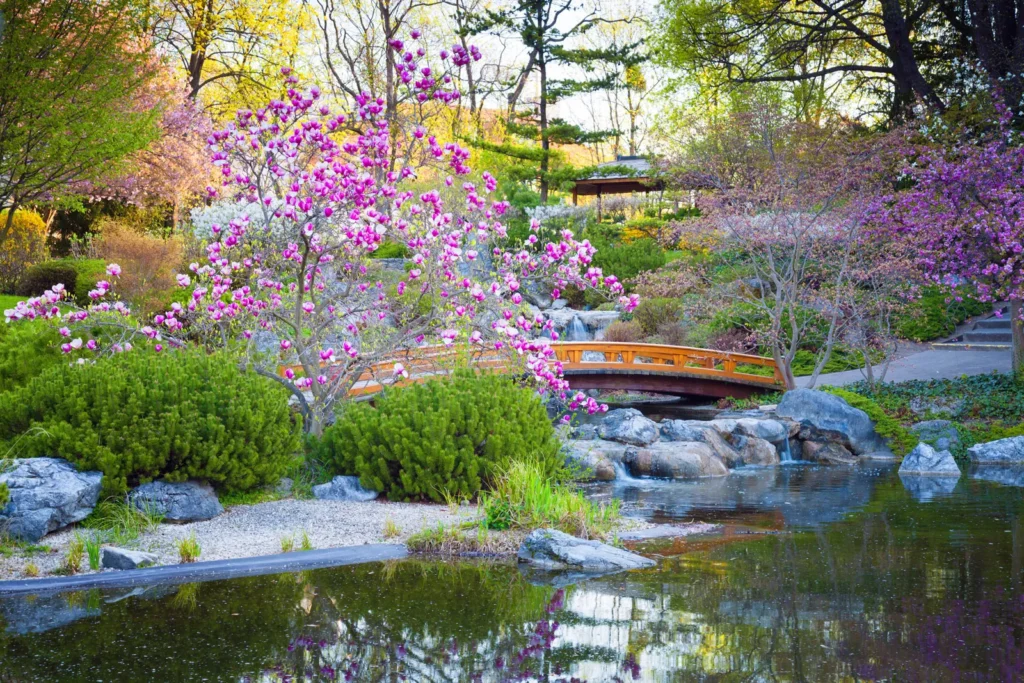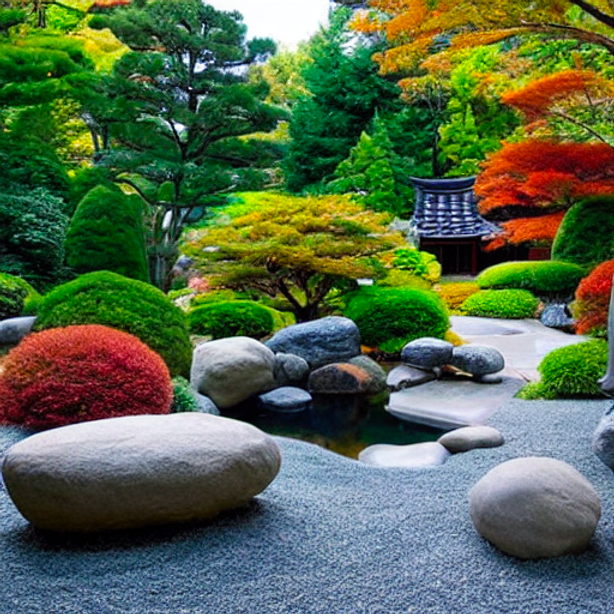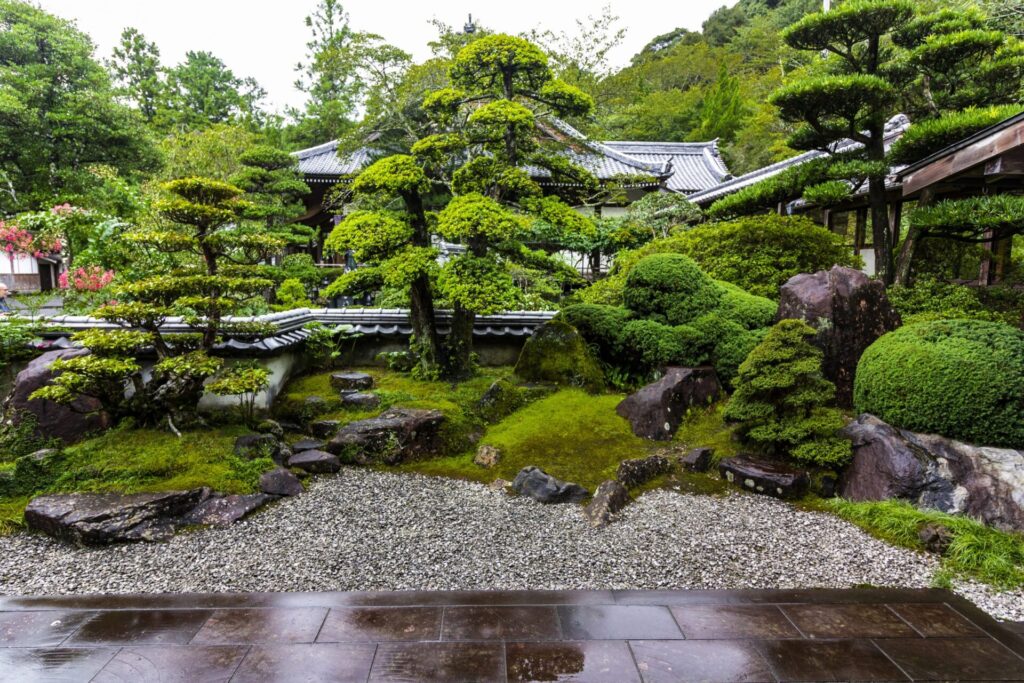Japanese gardens have long been celebrated for their serene beauty, providing an oasis of tranquility amid the hustle and bustle of modern life. Infused with the principles of Zen philosophy, these gardens are meticulously designed to offer a space for contemplation and inner peace.
Recreating a Japanese garden in your backyard allows you to bring this harmonious ambiance into your daily life, fostering a sense of calm and balance. In this article, we’ll explore the essential elements and guiding principles behind crafting your own tranquil haven inspired by the beauty of Japanese landscaping. In case you are driving to a shop after reading this article to buy all you need and your driveline starts making strange noises, you might want to consider taking a detour to your local shop for driveline repair in WNY.
Embracing Simplicity in Design
The cornerstone of a Japanese garden lies in simplicity. Embrace the concept of “Wabi-Sabi,” finding beauty in imperfection and impermanence. Begin by decluttering your space, eliminating the unnecessary to achieve a minimalist landscape. Utilize natural elements such as gravel, stone, and sand to create a simple yet sophisticated setting. A gravel pathway leading through the garden not only serves a practical purpose but also adds a sense of harmony and elegance to the environment.
Large rocks or boulders strategically placed amidst carefully pruned shrubs and trees can symbolize mountains or islands, adding depth and character. The selection of plants is crucial; opt for native species like bonsai, maple, bamboo, or cherry blossoms to maintain authenticity and create a serene atmosphere. Group plants in odd numbers, following the traditional Japanese design principles. In case you want to visit a Japanese garden in Belgrade and you need a vehicle for that, consider renting a car from Rent a Car Beograd.
Harmony in Elements

Achieving harmony among the elements is pivotal in a Japanese garden. Incorporate water features such as a small pond or a carefully positioned stone basin (tsukubai) to evoke a sense of tranquility. The soothing sound of trickling water can create a serene ambiance, while the reflective qualities of the water surface add depth to the garden. Surround the water feature with moss, rocks, or plants to blend it seamlessly with the surroundings.
Create balance by integrating elements of Yin and Yang. A balance between stillness and movement can be achieved by introducing a carefully placed bridge or lantern, offering focal points that complement the natural flow of the garden. The bridge symbolizes a transition and invites exploration, while the lanterns when illuminated at night, infuse the garden with a mystical charm. If you have a business for selling Japanese plants and are considering selling, a team of experienced M&A advisors can help you achieve your goals of expanding it or selling it for the right price.
Mindful Maintenance
Mindful maintenance in a Japanese garden goes beyond the routine care of plants and structures; it’s a spiritual practice that deepens your connection with nature and your garden’s essence. It’s a form of meditation in itself, allowing you to be fully present in the moment as you tend to your outdoor sanctuary.
Pruning and shaping the plants is not just about aesthetics but about encouraging their natural growth patterns. Each snip of the shears and careful trimming should be done with respect for the plant’s unique character, aiming to replicate the wild beauty found in nature.
Raking the gravel or sand isn’t merely about tidying up; it’s an opportunity to create ripple patterns that symbolize water’s ever-flowing nature or the peaceful waves on a pond’s surface. Each stroke of the rake should be deliberate, carried out with a sense of reverence, and with the knowledge that it’s a form of artistic expression. If you want to protect your garden consider hiring a company for access control system installation in Philadelphia.
As you care for your garden, take moments to pause and simply listen to the sounds around you. The gentle rustling of leaves, the distant chirping of birds, or the soft gurgle of water in a fountain – all these contribute to the symphony of your garden’s serenity. By embracing these sounds and being present in the moment, you deepen your bond with the natural world.
In the process of mindful maintenance, your garden becomes a canvas for your emotions and thoughts. It’s a place where you can contemplate life, find solace, and seek inner peace. This meditative approach to tending your Japanese garden not only ensures its continued beauty and health but also becomes a source of personal enrichment and tranquility. If your garden vehicle is locked, car lockout service can help you get back inside quickly and safely.
Fostering a Connection with Nature
A Japanese garden is more than just an outdoor space; it’s a bridge to nature. This connection is vital in channeling the tranquility that these gardens are known for. To enhance this connection, consider introducing a tea house or a contemplation pavilion within your garden. These structures provide a space for meditation, tea ceremonies, or simply a quiet spot to admire the garden’s beauty.
The incorporation of bonsai trees is another way to foster a deep bond with nature. Bonsai, with its centuries-old tradition, represents the beauty and harmony found in nature’s miniature form. Cultivating and caring for bonsai trees can be a therapeutic practice, allowing you to engage with nature on a more intimate level. If you have horses in your garden and want to make them look more beautiful, you can drape saddle blankets over their backs.
A Seasonal Symphony

Japanese gardens change with the seasons, offering a different experience throughout the year. Embrace this natural ebb and flow by selecting plants that flourish in different seasons. Cherry blossoms, known as Sakura, bring a burst of pink and white in spring, while maples provide a vibrant tapestry of colors in autumn. Admiring the ever-evolving garden as the seasons transition adds an element of surprise and delight to your backyard retreat.
As the seasons shift and the landscape transforms, you can embrace the ephemeral beauty of nature by incorporating decorative elements like wind chimes and stone arrangements into your garden. These elements can evolve with the changing seasons, mirroring the garden’s metamorphosis and forging a deeper connection with the passage of time.
As we celebrate the changing seasons and the beauty of nature, let’s also take a moment to support our local schools by participating in a readathon school fundraiser. These fundraisers help to provide vital resources for our students and teachers, ensuring they have the tools they need to succeed.
As you stroll through your garden, the gentle tinkling of wind chimes might remind you of the playful breezes of spring, while the weathered hues of stone arrangements evoke the earthy depths of autumn. Whether you’re seeking a tranquil retreat amidst the vibrant blooms of summer or a cozy sanctuary during the hushed serenity of winter, these decorative touches will enrich your outdoor experience and serve as a constant reminder of nature’s ever-changing cycle.
And if you’re looking for a wide selection of disposable vapes to enhance your outdoor enjoyment, be sure to visit our disposable vapes shop.
The Role of Stones in Japanese Gardens
Stones hold a special place in Japanese garden design. They symbolize stability and longevity and are often used to create paths, borders, and focal points. Consider using stepping stones to guide visitors through the garden, encouraging them to take a mindful journey through the space. Irregularly shaped stones can add a touch of natural charm, enhancing the feeling of wandering through a secluded forest.
The arrangement of stones also contributes to the garden’s overall composition. Use them to create islands, shorelines, or even abstract representations of animals or other natural elements. The positioning of stones should appear as though they have naturally settled into their places, further emphasizing the garden’s connection with nature. If you have any devices and need help setting them up, consider contacting a company for managed IT services in San Antonio.
Inviting Wildlife
Japanese gardens are not just static landscapes; they are living environments that aim to harmonize with nature. To deepen the connection to the natural world, it’s essential to invite wildlife into your garden. Incorporating elements that attract birds, butterflies, and other creatures adds a dynamic layer to your tranquil haven. For those seeking a property with ample space to realize their Japanese garden dreams, consider exploring the stunning homes in Boca Bridges.
One way to welcome wildlife is by introducing a bird feeder. Hang it from a tree or place it strategically within your garden. Bird feeders stocked with a variety of seeds can entice various avian visitors. The cheerful chirping and fluttering of birds not only add an auditory dimension to your garden but also make it feel more alive.
Consider adding a small fishpond or a water feature that can host aquatic life. The gentle movement of fish and the soothing sound of water can enhance the ambiance of your garden. Koi fish, with their vibrant colors and graceful movements, are a traditional choice that can become a focal point in your garden’s aquatic ecosystem.
Incorporating a butterfly garden is another way to engage with nature. Select plants that attract butterflies, such as milkweed, coneflowers, and butterfly bushes. These plants provide nectar for the butterflies and create a colorful spectacle as these delicate creatures flit about your garden. As you enjoy the beauty of your butterfly haven, you may need a convenient and secure place to store your RV. Consider RV storage in Albuquerque to keep your vehicle safe and protected when it’s not in use.
Be mindful of not using pesticides in your garden, as these can harm the very wildlife you’re trying to attract. Organic gardening practices can help maintain a healthy and biodiverse ecosystem.
By inviting wildlife into your Japanese garden, you not only enrich its natural beauty but also establish a deeper connection with the environment. Your garden will become a dynamic, ever-changing space, where the presence of birds, fish, and butterflies contributes to the overall sense of serenity and balance. It’s a testament to the harmony achieved when nature and human design coexist in perfect balance. If you have a Japanese garden website and want to improve its ranking, consider hiring a Colorado Springs SEO company to help you optimize your site for search engines.
The Power of Patience

In the fast-paced world we inhabit, patience can often feel like a scarce commodity. However, when it comes to cultivating a Japanese garden, patience is not only a virtue but a guiding principle. The essence of Zen philosophy, which underpins these gardens, encourages us to slow down, be present, and appreciate the beauty of the moment.
The power of patience extends beyond the initial creation of your Japanese garden. It’s an ongoing commitment to the art of nurturing and cultivation. As you plant the seeds, arrange the stones, and tend to the bonsai, you’ll find that the true beauty of your garden emerges gradually, mirroring the serene passage of time.
This patience becomes an essential aspect of your own personal growth as well. As you engage with your garden, you’ll learn to appreciate the delicate balance of life and the significance of gradual change. You’ll find that the journey of tending your garden is a form of meditation in itself, allowing you to disconnect from the chaos of daily life and reconnect with the natural rhythms of the earth. Boulder tutors can help you learn more about gardening and how to care for your plants so that they can thrive.
Japanese gardens are a testament to the enduring relationship between humanity and nature. They remind us that beauty often unfolds in its own time, and by embracing this truth, we can find profound joy and satisfaction in the process. Your garden becomes a living canvas, ever-evolving, and a reflection of your commitment to the art of Zen in your own life.
As you continue to nurture your Japanese garden, you’ll witness the transformation of your outdoor space into a sanctuary for contemplation, a space where time seems to slow, and the beauty of nature becomes more profound with each passing season. However, if your basement floods, it can be a major setback to your peace of mind and enjoyment of your home. That’s why it’s important to have the contact information of a good company for basement flood clean up in Charlotte on hand, just in case.
Conclusion: Cultivating Your Tranquil Haven
In the art of Zen, the creation of a Japanese garden in your backyard is a transformative journey. It’s a testament to the human spirit’s innate desire for serenity and harmony, and it offers a profound connection with nature. As you’ve delved into the principles of simplicity, harmony, and mindful maintenance, you’ve not only crafted a beautiful outdoor space but also nurtured your own soul. In case you want to travel across Japan and visit unique gardens there, you can rent a Forest River Wildwood RV.
Your garden, inspired by the timeless traditions of Japan, is a place of refuge, reflection, and rejuvenation. It embodies the essence of wabi-sabi, where imperfection is celebrated, and the ever-changing seasons are welcomed with open arms. The ripple patterns in the gravel, the careful placement of stones, and the mindful selection of plants all tell a story of your commitment to a more tranquil way of living.
Embracing the Zen philosophy, your garden is a living canvas of mindfulness, where the act of tending to it becomes a form of meditation. The deliberate pruning, raking, and listening to the sounds of nature merge to create a profound connection with the world around you.
As you walk through your garden in different seasons, you’ll witness the ebb and flow of life’s cycles, mirrored in the changing colors and moods of your sanctuary. With patience and dedication, your garden continues to evolve, a reflection of your own growth and inner peace. In case you are building a garden on your roof, consider a company for commercial roofs in San Diego to secure the structural integrity and waterproofing of your rooftop oasis.
In the end, the creation of a Japanese garden is an ongoing and rewarding journey. It’s a reminder that tranquility can be cultivated in the midst of our bustling lives. Through the art of Zen, your garden serves as a tranquil haven, inviting you to slow down, breathe deeply, and find solace in the timeless beauty of nature. In every stone, plant, and carefully tended detail, you’ve crafted a piece of Japan’s serene spirit in your own backyard – a sanctuary for the soul.
